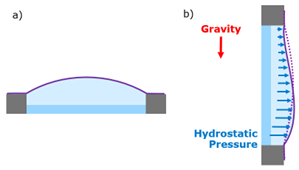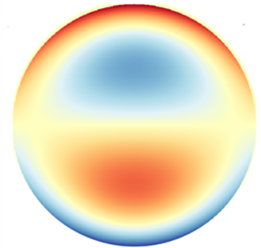The decision to integrate liquid lenses into iToBoS’ full-body scanner was taken due to the need to take thousands of pictures in the shortest amount of time.
The compactness and fast-focusing capabilities of the liquid lenses made them the best solution. However, due to their liquid nature, the original liquid lenses show a worse performance when they are used horizontally oriented (optical axis) than vertically oriented. The reason is that in the vertical axis configuration, the weight of the liquid on the deformable membrane is the same throughout the full area of the lens and the membrane deforms isotropically. Instead, when the lens is used at a different angle, in the worst case with the optical axis horizontal, the liquid pushes the membrane more on the lower side of the lens than on the upper side (hydrostatic pressure) and deforms it asymmetrically.

Figure 1. a) Liquid lens in vertical (optical) axis configuration. b) Liquid lens in horizontal axis configuration. The membrane deforms asymmetrically due to the effect of asymmetric hydrostatic pressure.
The result of the asymmetric deformation of the membrane is an optical aberration called coma. This aberration is characterized by a region of higher optical power on one of the hemispheres of the optical surface and a region of lower optical power on the other hemisphere. In the case of the gravity-induced coma that appears on liquid lenses in horizontal optical axis configuration, these two hemispheres are aligned with the gravity, i.e. top and bottom of the optical aperture (see Figure 2).

Figure 2. Optical power (arbitrary units) of the coma aberration. The lower/higher optical power zones appear in the top/bottom hemispheres in the case of the gravity-induced coma of the liquid lenses.
Because of this effect, liquid lenses are advised to be used in a fully vertical position. Some applications allow for this architecture. Other applications, rely on mirror systems to overcome this problem and “redirect” the optical axis. Unfortunately, in some cases, the use of mirrors is not possible due to spatial constraints or the difficulty of keeping many elements aligned. This is the case of the iToBoS full-body scanner, where the distance towards the patient is already limited due to safety reasons, and adding a mirror in the optical path would only make the situation worse. That is why one of the main tasks of Optotune in the iToBoS project is to solve the gravity-induced coma aberration of liquid lenses. In a following blog entry, we will explain how. Stay tuned!
